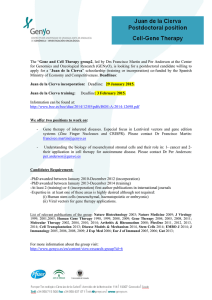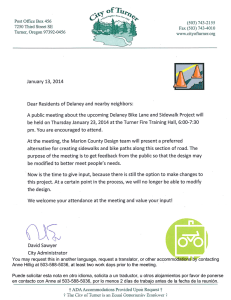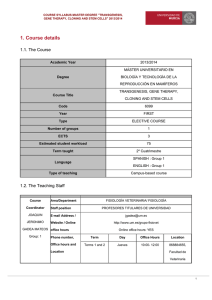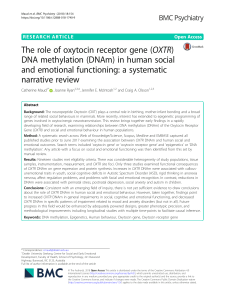A bioinformatic gene hunting
Anuncio
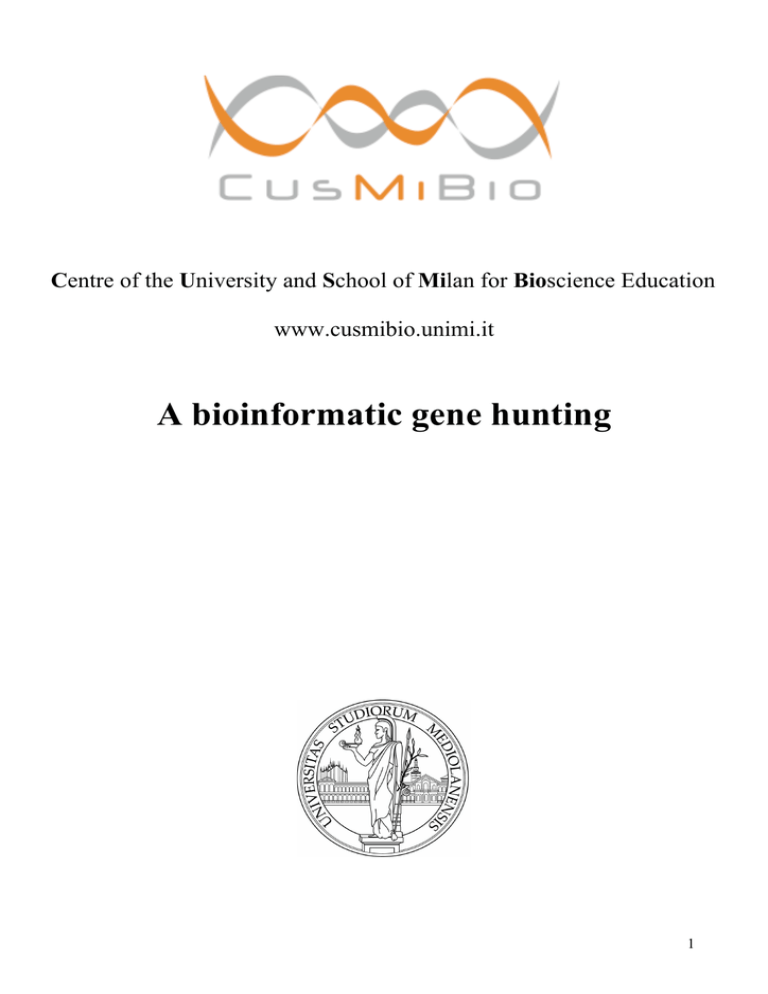
Centre of the University and School of Milan for Bioscience Education www.cusmibio.unimi.it A bioinformatic gene hunting 1 The Cus-Mi-Bio staff, composed of both University Professors and High School teachers, are the scientific editors and authors of this Handbook’s contents. Workshop Leaders Giovanna Viale Professor of Biology and Genetics, Dept. of Biology and Genetics for Medical Sciences, University of Milan, via Viotti 3/5, Milan, Italy Cinzia Grazioli High school teacher fully working at Cus-Mi-Bio Dept. of Biology and Genetics for Medical Sciences, University of Milan, via Viotti 3/5, Milan, Italy Tutors Monica Fornari, Priscilla Manzotti, Lisa Bellora PhD students, University of Milan, Italy 2 Gene Hunting GOALS of this activity are to: 1. identify the gene to whom an unknown DNA sequence (probe) belongs; 2. identify the chromosomal region where the gene is located; 3. define the exon-intron structure of the gene and obtain the complete cDNA sequence, i.e the coding sequence; 4. identify the main features of the cDNA molecule, and draw a scheme in which the nucleotide positions of the start codon, the stop codon and the polyadenylation signals are shown; 5. translate the cDNA molecule into the corresponding protein; 6. obtain informations on the 3D structure of the protein; 7. learn how to correlate a gene mutation with a disease. The aim of this practical is to teach how it is possible, via online biological databases, starting from a partial human DNA sequence, to identify the gene to which it belongs, identify differences between this sequence and the normal sequence, obtain detailed informations about the protein codified by this gene and on its expression pattern, i.e. the tissues in which this gene is expressed. Moreover, information can also be retrieved about the disorders associated with alterations of the gene. You are given a partial DNA sequence (probe) and with it you have to fish the corresponding gene. You will succeed in finding the needle in the haystack! 3 Scenario Predictive testing is offered to asymptomatic individuals with a family history of a genetic disorder. In the proposed case, a predispositional testing (eventual development of symptoms is likely but not certain when the gene mutation is present) is asked by a woman with a family history of breast cancer (see pedigree of the proband). Anne, a 23-year-old woman, goes to her first appointment with her new gynecologist. In taking her history, the doctor notes that several of Anne's family members have had cancer. Her paternal grandmother died at the age of 40 of breast cancer, two of her four paternal aunts died in their early 50s of ovarian cancer, and a third paternal aunt has recently been diagnosed with breast cancer at the age of 39. The gynecologist suggests that a mutation in one of two known breast cancer genes (BRCA1 or BRCA2) is running in Anne's family. During the visit, the gynecologist finds a suspect nodule in her right breast and takes a biopsy. The gynecologist suggests that, besides the hystological examination of the biopsy, Anne should also have a DNA testing but informs her that such test results will only be meaningful if she knows the mutation running in her family. Anne contacts her affected aunt who, she learns, has already had genetic testing. Results showed that her aunt has a somewhat rare mutation in BRCA2 gene. The bioptic specimen is sent to the lab to perform BRCA2 DNA testing. In the diagnosis of genetic diseases a laboratory technique called reverse transcription polymerase chain reaction (RT-PCR) is widely used. RT-PCR is a technique for amplifying a defined piece of a ribonucleic acid (RNA) molecule. The RNA strand is first reverse transcribed into its DNA complement or complementary DNA (cDNA), followed by amplification of the resulting DNA using polymerase chain reaction. RT-PCR uses as template mRNA molecules and therefore is suitable for tissue specific gene expression analysis. On Anne’s breast tissue specimen, RTR-PCR targeted to the DNA region containing the mutation previously identified in her aunt is performed. The PCR product is sequenced. You will use this sequence (a partial cDNA sequence) as a probe to identify the mutation involved in Anne’s family and to search for the presence of the mutation in Anne’s DNA. 4 Aim 1: Identify the gene to whom the DNA sequence (probe) belongs and its chromosomal location; Aim 2: Identify the mutation present in Anne’s DNA. You can use the software BLAT (BLAST-Like Alignment Tool), an algorythm optimized for comparing cDNA sequences (with no introns) and genomic sequences (containing introns). Connect to the site: http://genome.ucsc.edu/cgi-bin/hgBlat?db=mm2 Paste the nucleotide sequence TGCACTAACAAGACAGCAAGTTCGTGCTTTGCAAGATGGTGCAGAGCTTTATGAAGCAGTGAAGAATGCA GCAGACCCAGCTTACCTTGAG TTATACTGAGTATTTGGCGTCCATCATCAGATTTATATTCTCTGTTAAC AGAAGGAAAGAGATACAGAATTTATCATCTTGCAACTTCAAAATCTAAAAGTAA ATCTGAAAGAGCTAAC ATACAGTTAGCAGCGACAAAAAAAACTCAGTATCAACAACTACCG GTTTCAGATGAAATTTTATTTCAGA TTTACCAGCCACGGGAGCCCCTTCACTTCAGCAAATTTTTAGATCCAGACTTTCAGCCATCTTGTTCTGA in the white box to find its location in the human genome (check that the human genome has been selected) and click “submit”. The BLAT search results page lists several records. You choose the first one which shows the best alignment score. You find that your sequence (query) is 350 nucleotide long and is located in chromosome 13. If you want details for the exon-intron structure of the genomic region of any of the listed records, click “details” (you will use this function later on); you now click “browser” to find the 5 chromosomal region containing the sequence of interest. In the following page, in the box with the chromosome ideogram, a red bar identifies your sequence’s position on the chromosome. In the interactive figure below the ideogram you find your sequence and, below, the alignment of this sequence to the genomic sequence. To understand the content of this page, you need to refresh your informations about gene architecture. Genes are only 1% of human genome. Scientists are still trying to understand what is the composition of the other 99%. In eukaryotes, genes are often flanked by long stretches of non coding sequences, whose meaning is still mostly undefined (these sequences are sometimes called “junk DNA”); when a gene is found, its sequence is fragmented in small pieces (exons). In genes, the coding parts (for proteins or just RNA molecules), i.e. the “text” (exons) are separated by other long non-coding DNA sequences (introns). In the figure, the aligned regions (exons, remember that a cDNA sequence is just a collection of all the exons) are shown as blocks (black or red), while the regions with no alignment (introns) are represented by a thin line. Take note of the position (13q12.3) and the nucleotide residues (chr13:31,848,838-31,852,238) listed above the chromosome ideogram and representing your query sequence position on chromosome 13. Click on Known genes to find the gene to which the query sequence belongs. As expected, the gene is the BRCA2 gene. How many exons are visible in this part of the gene? 6 Compare the query sequence and the corresponding region in the normal gene. How many exons are present in the query sequence? Can you identify any major difference between the query and normal gene sequences? What can you conclude about the mutation in Anne’s DNA? In this page you can also find other important pieces of information. On the left, you see grey and light blue vertical bars. The browser interface allows you to personalize your search (visualize some information, hide and add selected pieces of information). Clicking the various vertical bars on the left, you access a page showing the content and how to change the parameters to obtain the information you’re looking for. Move your attention to the vertical bar relative to sequence conservation (Vertebrate Alignment and Conservation). Note that most conserved regions corresponds to exons regions (filled rectangles, in blu in the RefSeq genes section) and that these regions remain conserved also in vertebrate species evolutionarily more distant from human, such as opossum, chicken and frogs. A certain degree of conservation also exists in some non-coding regions (conserved non-coding sequences) whose role is still poorly understood but that could be involved in regulation of gene expression. Of the last two bars, the first shows the SNPs (single nucleotide polymorphisms) and the last one, Repeat masker, identifies repeated sequences. Now we want to identify which is the missing exon in the mutation present in Anne’s family. To obtain this piece of info, you need to find the complete exon-intron structure of the whole BRCA2 normal gene. In order to do this, you first need its complete coding sequence (CDS) and perform a new BLAT search. Go to http://www.ncbi.nlm.nih.gov/ to find the identifier of the BRCA2 gene. Select “Nucleotide” in the search box in the upper left part of the home page and type “BRCA2 homo sapiens” in the “for” box next to it. Find in the list of records BRCA2 Homo sapiens breast cancer 2, early onset (BRCA2), mRNA. Take note of the accession number NM_000059 (NM stands for normal mRNA). 7 Click on NM_000059 and find a typical GenBank nucleotide file. A lot of it is hard to read, but a few things are clear. First, under references, you find citations to the publication of this sequence in the scientific literature. To see an abstract of the article in which this gene is described, click the PubMed link below the reference. Scrolling down the page you can find info on the gene mutation. At the bottom of the page, in the Features section, you find the cDNA coding sequence (CDS). This is the suitable sequence for your BLAT search. The CDS sequence is not in the form that is most useful for searching in databases for related genes. Let's display this entry in a form more useful for searching. At the top of the page, beside the Display button, pull down the menu and select FASTA. Click Display. Save this file, choosing text or plain text as the file format. Call it cDNAFASTA.doc. In the same section, also find the aminoacid protein sequence, copy it and save it to a word file you name BRCA2 protein.doc. Take note of the number of aa residues of the normal protein. Return to http://genome.ucsc.edu/cgi-bin/hgBlat?db=mm2 and paste the full cDNA sequence (in FASTA format) in the BLAT search box. As you already know, this software allows to easily compare cDNA sequences and genomic sequences and to identify the exon-intron structure of a given gene. Submit and, in the results page, click “details” on the left of the first record (score 11.350, 11.386 nucleotides, 100% identity). 8 In the following page, you find your cDNA sequence and, below, the alignment of this sequence to the genomic sequence. Matching bases in cDNA and genomic sequences are colored blue and capitalized. Light blue bases mark the boundaries of gaps in either sequence (often splice sites). In the genomic sequence below, the aligned regions (exons) are shown in capital blue letters while the regions with no alignment (introns) are in small black letters. Click on links, in the frame to the left, to navigate through the alignment. Clicking on the various blocks, you are directed to the corresponding exon in the genomic sequence. The BRCA2 gene has 27 exons. Your task now is to identify which is the missing exon in the mutated BRCA2 gene. In the genomic sequence, find the nucleotide residues (chr13:31,848,838-31,852,238) corresponding to your probe position on chromosome 13 (see above, page 13). Now you should be able to answer the question: which is the missing exon in the mutated BRCA2 gene? You can conclude that Anne is a carrier of a mutation consisting in absence of exon 22. This mutation is a splice site mutation (G to A substitution) in intron 21 conserved splice acceptor site, which results in complete loss of exon 22 (Wagner TM et al 1999, PMID: 9971877). Copy the missing exon sequence and save it in a text file named “missing exon.doc”. Aim 3 Find info on the normal BRCA2 protein function Open the Swiss Prot homepage at http://www.expasy.org/sprot/sprot-top.html Swiss Prot is a curated protein sequence database which strives to provide a high level of annotation (such as the description of the function of a protein, its domains structure, post-translational modifications, variants, etc.), a minimal level of redundancy and high level of integration with other databases. At the top of the page, a search field is available to submit a QUERY term; type BRCA2 human, click GO and, in the next 9 page, find the record of the human BRCA2 protein (note the identifier P51587). Click on it . The new page contains information grouped in categories [Entry info], [Name and origin], [References], [Comments], [Cross-references], [Keywords], [Features], [Sequence], [Tools], easily identified by blue horizontal bars. Scroll up and down the page to study the different categories of information available. Scroll the page to the section [Comments] and read important info on protein function, localization and tissue expression. The information in the “Cross-references” section of this SwissProt entry provides links to other databases containing additional information about BRCA2. They are directly accessible by clicking on the accession numbers or identifiers given in the Cross-references. For example, the gene sequence is available from EMBL Genbank, the domain composition from SMART, the coordinates of the 3D structure from PDB, Prosite, InterPro and Pfam, the deseases associated with alterations of the gene/protein from OMIM. Take note of the accession numbers of PDB (1nOw), SMART (P51587) and OMIM (several records, all preceded by MIM). Aim 4 and 5 Consequences of the mutation at the protein level. Can you predict the consequences of the loss of exon 22 on BRCA2 protein structure/function? To answer this question you have to construct an mRNA molecule (or a cDNA molecule) devoid of exon 22 and translate it into the corresponding aminoacid sequence. Find the normal cDNA sequence in your text file cDNAFASTA.doc. Find the exon 22 sequence (you have saved it in the “missingexon.doc” file) in the normal cDNA sequence (remember that a cDNA sequence is just a collection of all the exons) and delete it. The Word function FIND will help you in finding exon 22 within the cDNA sequence. Make sure that you delete exactly only exon 22. Save this sequence as cDNA22del.doc. 10 Now you can use a new software to translate this mutated cDNA sequence. Go to http://arbl.cvmbs.colostate.edu/molkit/translate/index.html Here you can translate your cDNA sequence into an aminoacid sequence. Just paste your cDNA sequence in the white box (yellow arrow) and click “translate DNA”. You will get an image with black background, where the results of the translation of your sequence in the six possible reading frames (three for each DNA strand) are represented. In green you will find the putative ATG start codons and in mauve the stop codons. Identify the frame with the longest open reading frame, ORF (i.e. the longest sequence without stop codons). In our case, the longest ORF is forward frame 3. Now click “Text Output” to visualize the sequence and its translation into aminoacids. Choose forward frame 3. You can easily personalize the software output (you can choose to visualize the aa sequence with the one or three letter code, alone or together with the DNA sequence). Choose “one letter code” and “amino acids and DNA”. Copy the whole content of the box in a new Word file (mutated protein.doc) using the font “courier new” or “courier”, font size 8, black; this font is suitable for sequence alignments since all the letters and spaces have the same size. Localization of the main features of the cDNA Now you can localize of all the main cDNA/mRNA features, i.e.: • 5’UTR (5’ UnTranslated Region) • start codon (start of translation, ATG (AUG) coding for methionine) • CDS (CoDing Sequence) 11 • stop codon (end of translation, TAA (UAA)/ TAG (UAG) / TGA (UGA) • 3’UTR (3’ UnTranslated Region) • polyA site (polyadenilation site) consensus sequence is “AATAAA” generally located 20-30 bp (max 10-35 bp) upstream the polyA tail. In some genes, this signal can slightly differ from the consensus sequence (i.e. ATTAAA). Identify all the above mentioned elements and mark them with the green and yellow highlighters. Starting from the 5’ end of the molecule, find the correct start codon, i.e. the first ATG, corresponding to the first methionine (M), not followed, at short distance, by any stop codon. Once identified the start codon, you can cancel the upstream aa sequence. This region (5’UTR) is not translated by the ribosomes into protein. You now find the stop codon (in this case a TGA codon) and the downstream sequence (3’UTR). The CDS (i.e. the sequence which is translated into protein) extends from nucleotide 228 to nucleotide 8988. Eventually, identify the polyadenilation signal, the sequence signalling the site where the primary transcript is cut and the polyA tail is added (starting at position 10.730) How long is the mutated protein? How long is the normal protein? Aim 6 Which are the main domains in the BRCA2 normal protein? Which domains are missing in the mutated protein? Open http://www.sanger.ac.uk/Software/Pfam/ Pfam is a large collection of multiple sequence alignments covering many common protein domains and families. For each family in Pfam you can, among others features, view protein domain architectures and known protein structures. Enter the swiss prot code for the BRCA2 protein P51587 in the search box. In the new page, the schematic representation of the BRCA2 12 protein is shown. The conserved domains detected by Pfam are depicted as boxes of different shapes and colours. In the left-part of the page you can view the overall description of the protein domains with the corresponding aminoacid residues. Look for the ~500 missing residues in the truncated protein (Anne’s mutation): they make the final part of the protein in which the Pfamb 12626 domain (aa 2900-3018) and an OB3 domain (aa 30523190) have been identified. Click on the Pfamb link (and in the next page on “View Graphic”) to find all the proteins containing Pfam-B_12626 domain. You find that this is a highly conserved domain present in the BRCA2 tumor suppressor protein of many different mammals and in birds. Click the OB3 link to learn about this domain’s functions. Report in a few lines the function of this domain. Available 3D structures of the BRCA2 protein Go to the NCBI home page and search the PROTEIN database for BRCA2 human (type the swiss prot P51587 code in the search box). This protein has the gi|14424438| identifier. On its right click on the link Blink. In the following page are listed 190 hits belonging to 39 species all showing alignments to the query protein. Click on the 3D structures button (in the row of buttons at the top of the page); in the next page you find the available 3D structures of the BRCA2 protein or of domains of it. Choose 1IYJD (the only 3D structure including the domains we are interested in) and click the blue dot next to it. 1IYJD is the structure of Rat BRCA2 protein (817 residues) - Dss1 chain A (45 aa residues) complex. The alignment of the Rat BRCA2 to residues 23853220 of human BRCA2 [gi: 14424438] is displayed. Click the “Get 3D structure data” Cn3D”. button This to “view in launches a program called 'Cn3D' (you may have to download the program to your computer, though). If Cn3D is already 13 installed on your computer, the “view structure” button will automatically open Cn3D. One window will display the 3D structure of 1IYJD (only the BRCA2 part of the complex is shown (while the 45 aa residues of Dss1 chain A in the complex are not shown). To view the alignment of your query sequence gi|14424438| against the sequence whose structure has been determined 1IYJD), open the window “sequence viewer” from the Menu Window at the top of the page. If you click on the letter/number combination to the left of the first amino acid in the top row in the sequence window, you can check what organism the crystal structure had been determined from. To see where in the sequence a residue is located, click it in one of the top rows in the sequence window and its position will appear at the bottom of the window. At the same time, you can follow a yellow tag showing the Rat BRCA2 aa residues in the 3D structure view. This program gives an interactive view of the protein. You have rotate and zoom option—rotate with mouse and zoom with “view”. You can also edit the Style. Choose “Rendering shortcuts” and “Worms” from the Menu Style to view the secondary strucure shown as tubes (α elices) and arrows (β strands). In principle one would like to align the wild type protein with its aberrant form. However, 3D structures are not available for many proteins. And even less often for different forms of the same protein. Thus, one has to resort to identifying the mutation (in our case deletion of exon 22) from the aminoacid positions in the sequence and inferring structural changes from the nature and position of the change. This is certainly less than optimal and will change with the availability of more accurate structure prediction algorithms that will allow to build testable hypotheses without having to experimentally determine the 3D structure of mutated proteins. Resolving protein structures experimentally is a tremendous effort and should be reserved for the final confirmation of already validated drug targets. Aim 7 Diseases associated with alterations of the BRCA2 gene To know about diseases associated with alterations of this gene, visit the OMIM database. Access from http://www.ncbi.nlm.nih.gov/ type either one of the accession numbers (MIM entries, found in the Swiss Prot Cross References section) or just BRCA2. 14 The BRCA2 gene (BReast CAncer 2) together with the BRCA1 gene represents one of the most important susceptibility gene for breast cancer and ovarian cancer development. BRCA2 was discovered studying Icelander families showing hereditary breast cancer. The BRCA2 and BRCA1 genes are tumor suppressor genes involved in the repair of chromosomal damage, although all their complex functions have not been as yet completely understood. Only 5-10% of breast cancers are hereditary forms of cancers. In these cases, in 90% of patients mutations in BRCA1 or BRCA2 genes are present. Researchers have identified about 450 mutations of the BRCA2 gene alone (>600 in BRCA1 gene). BRCA1 mutations are involved in 50-85% of hereditary breast cancers and in confering a 15-45% higher risk of developing ovarian cancer. BRCA2 mutations are responsible for 35% of hereditary breast cancers and confer a lower (10-20%) risk of developing ovarian cancer. They are also associated with breast carcinoma in males (6%). In both cases, a low increase (6-14%) of risk of developing other cancers (colon, prostate, pancreas) has been reported. In non hereditary (sporadic) breast cancers BRCA1 and BRCA2 mutations are very rare. The prevalence of cancer-predisposing BRCA2 mutations in the general population is unknown. Between 1/500 and 1/1000 individuals are estimated to carry a mutation in one of these two genes in the general population. Because of the founder effect, in different ethnic groups there might be just one or a few prevalent mutations. The following describes specific BRCA2 cancer-predisposing mutations in two ethnic groups: The BRCA2 cancer-predisposing mutation 999del5 occurs in 0.6% of the Icelandic population and in 7.7% of women and 40% of men with breast cancer from Iceland [Thorlacius et al 1996 , Thorlacius et al 1997]; The BRCA2 mutation 6174delT occurs with a frequency of about 1% in individuals of Ashkenazi Jewish descent [Struewing et al 1995 , Oddoux et al 1996 , Roa et al 1996 , Struewing et al 1997]. 15 In persons of Ashkenazi Jewish heritage, three founder mutations are observed: 187delAG (BRCA1), 5385insC (BRCA1), and 6174delT (BRCA2). As many as one in 40 Ashkenazim has one of these three founder mutations [Struewing et al 1997]. Now you have succeeded in finding the needle in the haystack! Not only you have identified the gene but you have gone a long way further: starting from the probe sequence you have collected a lot of information about the human BRCA2 gene and protein! You also have aquired a methodology to ask and answer at least some of your own questions (and those of your students) about the genome. Congratulations! A very successful hunting. Tunis. Bardo Museum. Hunting scene. Middle of the 3rd c. AD 16
